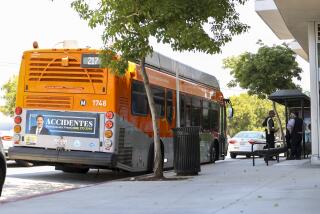Overhaul Urged for Valley Bus Route Network : Transit: Yearlong study recommends scrapping the grid system in favor of nodes served by a hub-and-spoke layout.
- Share via
The traditional grid system of bus routes in the San Fernando Valley should be scrapped in favor of a hub-and-spoke layout that would improve service to employment centers through links to commuter train and subway stops, according to preliminary recommendations for the first major overhaul of the area’s bus network in two decades.
At a workshop held Tuesday in Pacoima, transportation planners unveiled the initial findings of a yearlong study that proposes establishing several transit nodes throughout the Valley from which bus lines would radiate. Instead of being confined to north-south and east-west routes, buses would be routed to major commercial and retail destinations from hubs such as Metrolink stations and future Metro Rail stops.
Synchronized schedules would allow for easier transfers, and high-frequency shuttles--smaller than regular buses--would patrol well-traveled routes between and within communities, according to the recommendations, developed jointly by city and county agencies.
“This project has been a long time in the making,” said Russell Chisholm, manager of the study commissioned by the city Department of Transportation, the Metropolitan Transportation Authority and the county Department of Public Works.
“This is really the first all-agency (project) that’s been undertaken with regard to restructuring bus services.”
However, shadowing the sweeping study are proposed service cutbacks and fare hikes announced last week by the MTA. How the final recommendations will be accomplished in light of the MTA’s projected $126-million annual operating deficit remains to be seen, although officials are optimistic.
“I think we will be able to do most of what the study recommends,” said Mark Dierking, the MTA’s manager of government and public affairs for the Valley.
*
“This is a reallocation of existing resources,” not a request for more cash, added James Okazaki, chief of transit programs for the city.
Presented at a series of public workshops that began Tuesday, the proposals envision transit centers that hook up with Metrolink stations in Sylmar, Chatsworth and Burbank, and with a planned Red Line stop in Universal City. A major nexus would also be located at Warner Center, with others in Granada Hills and Sherman Oaks.
All would adopt a “hub-and-spoke” pattern of bus lines rather than adhere to the traditional grid system. New routes would allow bus riders to travel around neighborhoods and the Valley on a single bus, without many of the confusing transfers now required to change directions on the grid. “Timed transfers” for passengers needing to switch lines would synchronize arrivals and departures to eliminate long waits.
The study also suggests express services on busy streets, such as San Fernando Road and Van Nuys Boulevard, and along well-frequented routes, such as that between the northeast Valley and Chatsworth or Warner Center. Residents could also use local shuttles for shorter hops, modeled after the city’s DASH network.
“It’s very community-based,” Dierking said.
Although the study leans heavily on uniting bus and rail centers, the study’s backers said the proposals would not benefit comparatively more affluent rail commuters at the expense of regular bus riders, who are often poorer and dependent on public transportation. They noted that the recommendations call for neighborhood bus lines and increased service in less affluent areas such as the northeast Valley, where bus ridership is higher.
But at Tuesday’s forum in Pacoima, audience members cautioned that routes should serve not only employment centers but social service agencies, such as public hospitals and welfare offices.
Listeners also questioned the feasibility of the wide-ranging study at a time of fiscal turmoil for the MTA, the largest provider of bus service in the Valley.
“We can talk about all this restructuring all you want, but the question is whether you can pay for any of it,” said Irwin Rosenberg, a vice president with Laidlaw Transit Services, a Glendale-based private bus company. “I don’t see how you can separate this study from the $126-million deficit.”
Chisholm said planners kept the financial situation in mind in drafting the recommendations, which will be put in final form after all the workshops and presented to transit officials and policy-makers at a meeting in about two weeks.
If approved, after a process that could be delayed by the MTA’s current round of budget talks and labor negotiations, the study’s proponents hope that some of the short-range recommendations, such as consolidating some bus lines, can be carried out soon.
*
The $500,000 study was launched more than a year ago in an effort to gauge public opinion on the efficiency of the Valley’s bus network. While transit officials have adjusted and refined the grid system since its institution 20 years ago, the recommendations represent the most sweeping proposals yet for a region many residents feel is neglected by planners.
“That area (has) had the least amount of study since the grid went in,” said Okazaki of the city transportation department.
Prodded by Valley public transportation advocates, officials agreed to examine Valley bus service. Dierking said the decision has proven to be justified, given the Valley’s size.
“It’s 25% of the operating area of the MTA,” Dierking said. “So that’s a good place to start.”
More to Read
Sign up for Essential California
The most important California stories and recommendations in your inbox every morning.
You may occasionally receive promotional content from the Los Angeles Times.














